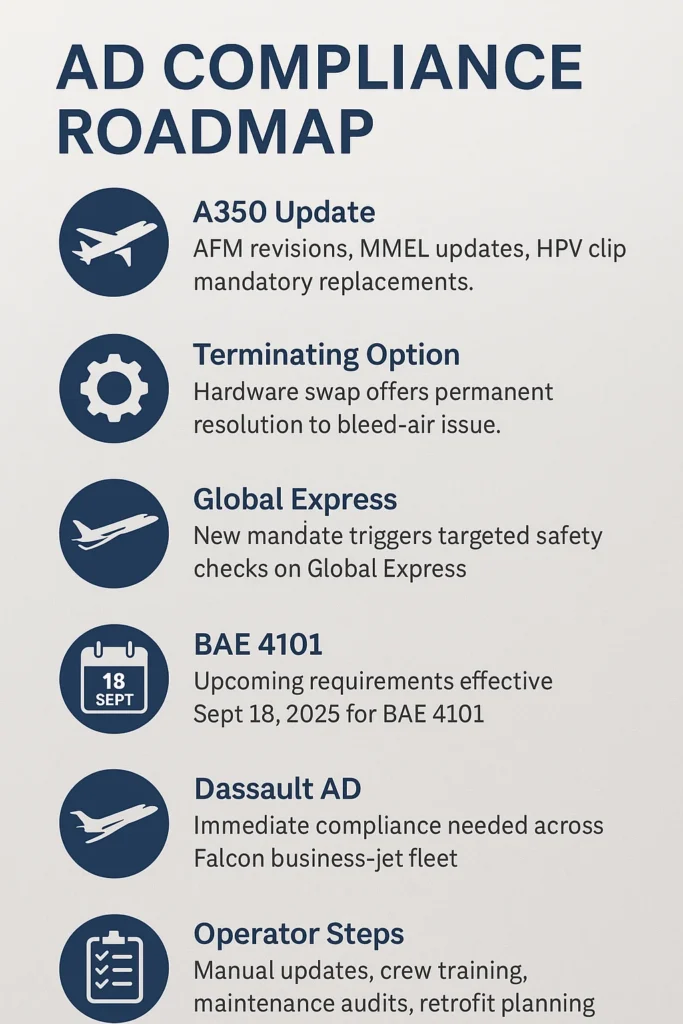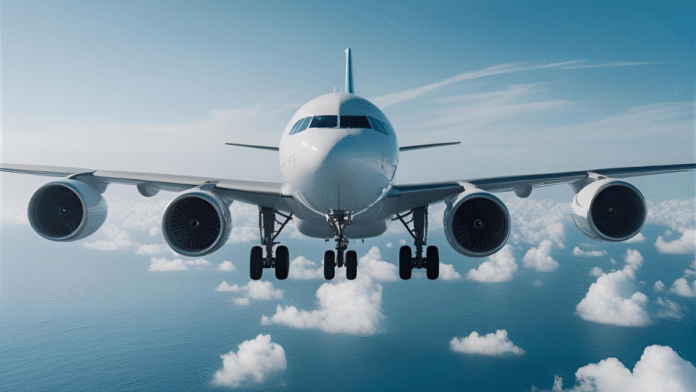Airworthiness Directive Airbus A350: FAA’s Aug 14, 2025 Airworthiness Directive covers A350 HPV clip mandates, Global Express, BAE 4101, and Dassault Falcon safety updates
Executive Summary
On August 14, 2025, the FAA issued final Airworthiness Directives (ADs) for the following aircraft: Airbus A350 series, Bombardier BD-700-1A10, BAE 4101, and Dassault Falcon 7X.
- Airbus A350: This directive requires a temporary revision to the Aircraft Flight Manual (AFM), an update to the Minimum Equipment List (MMEL), repeated replacements of the HPV clip, and includes optional actions for terminating hardware.
- Bombardier BD-700-1A10 (Global Express): The AD mandates inspections for oxygen hose clearances about electrical harnesses, along with any necessary corrective actions to be completed by September 18, 2025.
- BAE 4101 (Proposal Stage Post-2023 AD): This directive proposes updated and more stringent airworthiness limitations to better address risks related to fatigue and the fuel system.
- Dassault Falcon 7X: Effective August 14, 2025, this directive addresses hydraulic leaks in the spoiler control unit by requiring the replacement of the SPECU and prohibiting the installation of affected units.
Introduction
On August 14, 2025, the Federal Aviation Administration (FAA) took a significant step in enhancing aviation safety by issuing four carefully crafted Airworthiness Directives (ADs) specifically targeting wide-body airliners and business jets.
These directives go beyond mere technical requirements; they embody the FAA’s unwavering commitment to maintaining high safety standards in a rapidly evolving global aviation landscape.
Each directive addresses unique and potentially hazardous issues, ranging from hydraulic leaks that could compromise aircraft control to concerns about structural integrity that may affect overall flight safety.
Through these actions, the FAA sends a strong and clear message to the aviation community: safety and reliability are the foremost priorities in ensuring the well-being of passengers and crew alike.
Policy Overview
What are these policies?
They are the final FAA-issued Airworthiness Directives mandating changes in maintenance and operations to rectify identified unsafe conditions in the affected aircraft types.
Issuing Authority
Each AD originates from the FAA, implemented under its statutory authority to enforce aviation safety in the U.S. fleet.

Main Elements & Changes
- Airworthiness Directive Airbus A350: AFM temporary revision and MMEL updates; repetitive HPV clip replacement; optional terminating hardware upgrade.
- Bombardier BD‑700‑1A10: Requires detailed inspections for clearance issues between therapeutic oxygen hoses and electrical harnesses—corrections mandatory by September 18, 2025
- BAE 4101: Proposed AD to supersede 2023’s AD by incorporating new or more restrictive airworthiness limitations, targeting fatigue and fuel system risks
- Dassault Falcon 7X: Effective August 14, 2025, the AD mandates replacement of the spoiler power control unit electrical control (SPECU) to prevent hydraulic leaks and bans installation of affected parts
Background & Context
Bombardier BD-700-1A10 – Global Express
Prompted by Transport Canada AD CF‑2025‑02 (Jan 14, 2025), the FAA’s AD addresses noncompliant clearance between therapeutic oxygen hoses and electrical harnesses, along with missing separation safeguards. It mandates detailed inspections and corrective actions, with compliance due by September 18, 2025
BAE 4101
Following the 2022 UK CAA AD (G‑2022‑0006) and 2023 FAA AD (2023‑02‑06), ongoing analysis revealed additional structural fatigue concerns and fuel vapor ignition risks. The proposed 2025 AD will require further tightening of airworthiness limitations via updated AMM chapters.
Dassault Falcon 7X
Triggered by EASA AD 2024‑0224 and events involving hydraulic leakage from the SPPCU tied to SPECU failure, the AD requires replacing faulty SPECUs and prohibits reinstallation. The goal: prevent overheating and hydraulic leaks that could ignite fires during ground ops
Stakeholders & Affected Parties
- Operators: All affected fleets must implement manual revisions, scheduling inspections, and hardware replacements.
- OEMs: Bombardier, BAE Systems, and Dassault must support operators, possibly offering part replacements or design improvements.
- Pilots & Maintenance Teams: Need to update procedures and training in line with temporary operational limitations and maintenance schedules.
- Regulators & Authorities: Coordinated compliance across FAA, EASA, and other jurisdictions is essential.
Industry & Expert Reactions
- Operators are likely concerned about operational downtime and financial strain from inspections and replacements.
- Safety advocates and regulators will welcome the rapid action, particularly in preempting risk-driven incidents.
- OEMs are similarly expected to highlight warranty coverage or retrofit initiatives to mitigate operator burdens.
Implementation Challenges & Risks
- Operational Disruption: Tight deadlines for inspections, revisions, and replacements demand agile scheduling.
- Cost: Hardware replacements—particularly for the Falcon’s SPECU with an estimated cost of $22,600 per unit (covering ~160 U.S. aircraft)—are substantial.
- Global Coordination: Ensuring compliance aligns with EASA deadlines and avoids scope mismatch.
- Compliance Risk: Failure to implement on time jeopardizes safety margins and regulatory compliance.
Solutions & Best Practices

- Phased Planning: Prioritize aircraft nearing maintenance to combine AD compliance efforts.
- OEM Partnerships: Explore warranty or bulk-retrofit options to reduce costs and lead times.
- Training & Documentation: Issue clear instruction bulletins and flowcharts to crews and techs.
- Cross-Jurisdictional Tracking: Use joint FAA/EASA platforms to monitor compliance status fleet-wide.
Future Outlook
- Increased Safety Measures: Recent enhancements are anticipated to significantly lower the frequency of hydraulic leaks and system failures, thereby improving overall operational safety for users.
- Structural Evolution: OEMs may integrate design fixes into future production runs to avoid recurring fatigue or leaks.
- Regulatory Trend: This multi-fleet, multi-issue rollout reflects a maturing, data-driven approach to AD issuance.
Suggestions for Policy Amendments
- Subsidized Terminating Actions: Financial or logistical support to encourage permanent hardware fixes.
- Global Harmonization: EASA-FAA synchronization in AD issuance and compliance timelines.
- Enhanced Transparency: Publish operators’ estimated compliance costs and downtime for better preparedness.
FAA Airworthiness Directive 2025: Conclusion
These ADs underscore the FAA’s commitment to proactive airworthiness—spanning bleed-air, structural, environmental, and hydraulic domains. For operators, they create short-term strain. But in the longer term, they chart a path toward safer, more resilient aviation.
FAQ About Airworthiness Directive Airbus A350
- Why is the Falcon AD effective immediately (Aug 14) versus Bombardier’s delayed deadline?
Falcon SpecU leaks pose acute hazards; immediate replacements limit risk—Bombardier’s clearance issue involves scheduled inspections, allowing more time. - Will insurers waive premium increases for AD-related operational delays?
Possibly—documented compliance and OEM support can mitigate risk exposure from enforcement delays. - Are warranty or cost offsets available for hardware replacements?
Dassault’s cost estimate (~$22.6k per unit) may be offset partially by warranty, per FAA cost notes. - Where to find complete AD documentation?
Full AD texts are available via the FAA dockets on regulations.gov, under respective docket numbers (e.g., FAA-2025-0484 for Falcon 7X). - How do these ADs align with EASA directives?
All FAA ADs reference EASA’s prior findings (e.g., Falcon, Bombardier), maintaining bilateral consistency in safety action.
Pilot’s Handbook of Aeronautical Knowledge (2025): FAA-H-8083-25C Kindle Edition
- By Federal Aviation Administration Staff (Author) Format: Kindle Edition- 4. Rating 4.7 out of 5 stars (224)
- 4.3 on Goodreads
- 751 ratings
#1Best Sellers in Aviation Piloting & Flight Instruction
This post uses Amazon affiliate links. I may earn a small commission if you buy through them, at no extra cost to you.
Last update on 2025-12-26 / Affiliate links / Images from Amazon Product Advertising API

